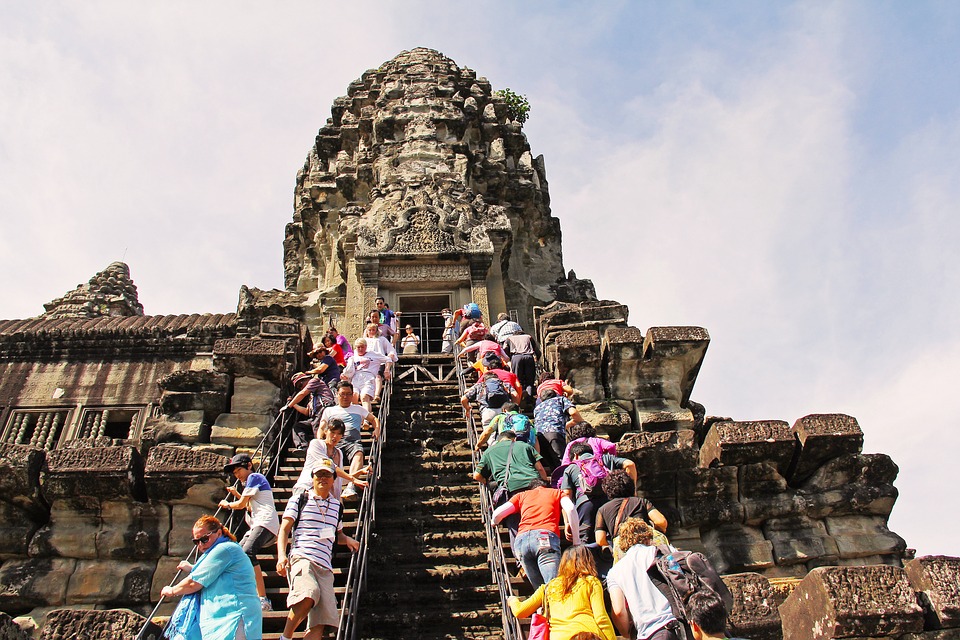In October 2020, EHL hosted its annual Sustainability Week with a vast array of online seminars, activities and discussion panels. Considering the current impact on the hospitality industry of ongoing COVID-19, the theme of sustainable tourism is more than ever a relevant and urgent topic. Under the direction of Joshua Gan (EHL regional director Asia-Pacific), the issues concerning the socio-cultural aspect of sustainable tourism – its meaning and implementation - were thoughtfully turned over by the two guest speakers: Dr. Peter Varga (Assistant Prof in Sustainability) and Mark Edleson (CEO of Alila Hotels & Resorts).
 EHL's Sustainability Week Logo
EHL's Sustainability Week Logo
The definition of Sustainability
According to the Environmental Protection Agency:
Sustainability creates and maintains the conditions under which humans and nature can exist in productive harmony that permit fulfilling the social, economic, and other requirements of present and future generations.
The analysis of sustainability is often divided into three main perspectives: social, economic and environmental, (also known as “people, profit and planet”). When talking about the social/people aspect, one could argue that an additional perspective needs to be taken into account - that of culture.
1. What is meant by “the socio-cultural aspect of sustainability”?
PV: The term refers to, among others, how the local community of a tourism destination is affected by the tourism industry. Hitherto, local cultural frameworks have often been neglected by the mass tourism industry. The perspectives of the tourism hosts should be taken into consideration in a more sustainable way, particularly in the developing world.
Much is normally erased for the sake of modern beach culture, bars, shopping malls, fast entertainment and consumerism. Little attention has been paid to erecting quality, authentic and culturally-rich experiences that benefit both host and visitors. As a result, the majority of todays’ tourism destinations are unsustainable due to various factors such as too fast development and lack of consideration of sustainable parameters, such as the environment and local communities. If tourism is to change and become more sustainable, the aspect of culture must be taken into account.
When we speak of culture in tourism it refers to both host and guest cultures. The goal is to create a harmonious sociocultural environment where long-term sustainable relationships are maintained among all the tourism stakeholders. This may seem excessively idealistic, nevertheless it is worth to try, at least to try and reflect on it in tourism development projects.
ME: Paying attention to the environment is now more pressing than ever. Despite the many labor and environmental regulations, few are actually adhered to. Tourism operators need to understand that sustainable tourism means more than just preserving the beautiful landscape of a tourist destination. It means, for example, respecting village mentality, places of worship, agricultural sites, all that is essential to the upkeep of local cultural identity. Operators have to ask themselves if what they are developing will be beneficial or harmful to the locals. Are they looking to promote mass tourism or quality tourism?
Mass tourism leads to land grabbing, wider roads, more transportation, traffic, pollution – many by-products that initially appear to be generating employment and returns, but that are damaging and simply not sustainable in the long run. The question today is: How to preserve the cultural fabric of a tourist destination?
2. Can you give examples of destinations that have remained socio-culturally intact?
ME: The Alila brand has based itself on a sustainable model from its inception and has tried to preserve as much of the original fabric of local life, culture and nature as possible. We use eco- designed constructions made out of local materials. We incorporate many sustainable initiatives, e.g. local water bottled in reusable glass jars, bamboo straws, organic gardens in the hotels’ compound, compost used from hotel waste, a ‘giving bag’ in each room where guests can leave anything they don’t want to take home, beach cleaning initiatives for staff and guests.

Image credits: Alila Hotels
We try to involve the locals in tourist activities where they are the beneficiaries and that naturally enhance the cultural vocabulary. A very successful initiative has been for local families to open up their homes to host dining experiences for visitors, thereby helping the village integrate the tourists and teach them about the local food and customs. This is precious, authentic interaction for the guests, as well as a means of showing respect to the villagers and developing ties with them. Reaching out respectfully to the community is an crucial step on the road to sustainable tourism.
PV: Some communities have kept their cultural rituals and turned them into interesting tourism features, which is an example of the revitalization of culture. For example, in South Africa, the Zulu dance has become a key tourist attraction, and subsequently, a commodity. Similarly, in other indigenous societies such as in the Amazon rainforest, the shamanistic presentations have become a commodity expected by tourists.
The positive outcome of this cultural ‘commodification’ is its economic benefits for the hosts and also the fact that locals keep the tradition alive. Other less appealing cultural elements for the guest will eventually be lost. Hence, the host culture is expected to adapt to tourism – but this is a fragile set up, because what if the tourism flow suddenly stops, as during this current COVID-19 pandemic? Local societies should not become too dependent on tourism, because it makes them economically fragile in front of unexpected global calamities.
A good example are the Guna people on the Caribbean side of Panama, who have intentionally made their precious small archipelagos an exclusive destination where leakage stays low, so economic benefits stay within their reach.
« The Guna are also one of the rare indigenous groups who seem to be striking a balance between their traditional ways of life and modern conventions. Since 1996, the business of tourism has rested solely in their hands, following a history of showdowns with investors who had seized lands and built luxury hotels and cabins without the blessing of the Guna General Congress. Today, the “Ley Fundamental Guna,” bans the sale or rent of Guna lands to outsiders, including Panamanians, as well as non-Guna investments in their territory. » - Mashable Media
Guana Yala Island (Image Credits: Go2Sanblas)
3. What’s the role of governments and stakeholders?
PV: Tourism has often been treated as a thriving industry by governments, especially in developing nations. However, as mentioned above, the local stakeholders are rarely taken into account, unlike the external ones (banks, developers, expatriate management, etc.) who tend to control everything. It can almost be seen as a form of neo-colonization, where the external stakeholders impose a specific type of development on the destination.
The economic return on mass tourism is considerable, but little attention is paid to the stress this causes to the local people and their culture. Some communities are very fragile in the face of mass tourism, it impacts their quality of life on a daily bases, both on tangible and intangible levels. Mass tourism may allow locals to buy mobile phones while they do not have indoor plumbing at home. Such odd ‘developments’ may generate a very unequal sociocultural environment in the destination. Even in developed countries, (take Venice for example), mass tourism had got so out of hand that the COVID lockdown was seen in many ways as a ‘blessing’ for the environment and many of the locals. There are some archeological sites, such as Angkor Wat in Cambodia to name just one among many, that risks destroying its own ‘raison d’être’ due to the uncontrolled over-tourism phenomenon.

Overtourism problem at Angkor Wat (Image Credits: Good-Travel)
ME: Governments tend to go for numbers, especially in developing countries. They are influenced by a business model that runs on economic drive and targets to be reached. Tourism is seen as an ‘export’. Tourism Officers are elected and their job is to see visitor numbers increase, which in turn causes stress to the local culture. DMCc (Destination Management Companies) have a vested interest in big groups of tourists because they stand to make a profit from tourists visiting certain shops and restaurants. In mass tourism, there’s a big circle of players all looking for their cut.
In the Bali village where I live, local teens are now going to tourism school whereas before they were going to an agriculture college. This was originally an agrarian society based on a farming economy. Land is now being sold to tourism not to farming. Tourism on this island means that some ties have been strengthened, others weakened. In order to strike a more balanced outcome, tourism must be more controlled in the future, even if that means making it more expensive.
4. How can tourists and governments change their mindset?
PV: Tourists need to start thinking about why they are traveling. There is something deeply wrong with the “why not?” mentality fueled by cheap air fares resulting in a few, fast days spent here and there. Travel has to become more purposeful. The idea of slow travel where the objective is to explore and immerse oneself in a new culture over a few weeks should be promoted. Travelers must change their expectations and mindset: show more care about their destination, do better research on simple local cultural specificities such as tipping, dress code, being respectful of the local culture, how to chat with locals, etc. We should do our best to avoid slipping back to pre-COVID times, and reflect on how to make tourism more sustainable.
ME: Ironically, COVID-19 has caused some necessary slowing down, with a refreshing new focus on domestic tourism. On one hand, the pandemic has helped de-emphasize material things, but on the other it has accelerated the craving for experiences. Hence, I am fearful that there will be a return to mass tourism once these restrictive times are over. Much will depend on whether the low-cost carriers are still in business or not. But essentially, it’s up to us, the travelers, to carry out more research into our destination and travel with a greater sense of purpose.
Conclusion
PV: As a brief conclusion of this panel, the future of tourism depends on how much attention we pay to sustainable aspects. The current pandemic has not only revealed a fragile tourism industry, but it’s also shown how stakeholders and destinations are suffering from a situation that, as yet, has no definitive end point. A more sustainable planning mindset, in all aspects of the tourism and travel sector, would enable us to prepare for an uncertain, but hopefully more responsible future.
"Contributing beyond education encourages the EHL community to give back to society by driving sustainable change wherever they live and work, both during and after their education. This is a strong call to action that should empower each of us to do more and play our part in making the world a fair, ethical and sustainable place". - Michel Rochat (CEO, EHL Group)






